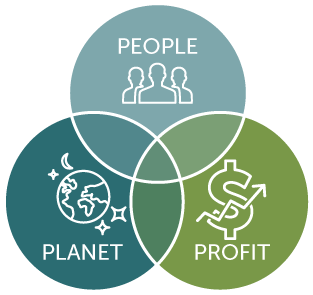Energy Efficiency | September 16, 2020
Go (for the) Green: How Triple Bottom Line Links Sustainability & Finance
Do you want to be sustainable or be financially minded? This has long been the narrative across many sectors and industries when running a successful business. It is commonly thought that sustainability and finance are opposing forces, and that you must sacrifice one for the sake of the other. This viewpoint is based on the idea that environmental regulations can slow business development, and that projects or investments for businesses to become more sustainable can be expensive. However, through the Triple Bottom Line approach, this narrative is starting to evolve.
Over the past 10-15 years, many leading companies across industries are discovering that sustainability and finance actually work well together. This development is due to a number of factors, including utility incentive programs and improved efficiency in products and equipment. As the financial benefits of sustainability have become more and more apparent, the Triple Bottom Line is helpful way to think about how sustainability and finance are now two intersecting aspects of any business model.

Graphic of Triple Bottom Line from Sustainable Management at University of Wisconsin.
The Triple Bottom Line
The Triple Bottom Line is not a new concept in the world of finance. Conceptualized over 25 years ago in the publications of British management consultant John Elkington, the Triple Bottom Line considers three factors equally important when evaluating the success of a company:
- Profit
- People
- Planet
This concept is closely related to the idea of corporate social responsibility (CSR), pushing the notion that a company should consider the effects of its business on the world around it. This view has been embraced by many famous and popular consumer brands, including Ben & Jerry’s, Patagonia and Starbucks, and has continued to gain more popularity.
Still, the definition of the Triple Bottom Line still seems to imply that profit and sustainability could be at odds with each other. In the years since this term was coined, however, this is simply not the case.
Financial motivators for sustainable business practices
It’s important to state it up front: energy efficiency projects can result in significant energy savings, as many companies today are discovering. Furthermore, the actual costs of these projects can often be reduced through utility incentives, lowering the out of pocket cost for companies to finance them.
In addition, more people are paying attention to the sustainability and CSR activities of companies – even large business evaluation corporations like Dow Jones are recording it. Many consumers, especially younger ones, are moving towards sustainability as a key factor in purchase decision and putting pressure on companies to maintain more sustainable practices. Let’s look at what these changes can mean for you.
Cost savings from decreased utility spend and avoided fines
The cost-savings of sustainability is one of the principal reasons that these practices have taken hold in the business sector. Through equipment upgrades and system projects that increase the efficiency and efficacy of energy usage, companies are seeing the benefit – and sometimes the necessity – of increasing energy efficiency. Plus, many products that increase your efficiency, such as LED lighting fixtures, are also higher quality. For a lower energy cost, LED lighting provides better, more consistent lighting levels and a longer-lasting installation than fluorescents, cutting down on maintenance costs.
In general, lowering energy usage reduces utility spend while simultaneously creating a more sustainable energy utilization. Meanwhile, waiting to implement an energy efficiency project may be costing your company more in the long run.
Also, there’s another cost to consider: fines. Many local and state governments are moving towards the reduction of carbon emissions, with states like California and New York leading the charge. Through the implementation of more energy efficient and sustainable practices, your facility can reduce carbon emissions and avoid potential or forthcoming fines in the future.
Company reputation and sustainability impact on business value
Beyond cost-savings, we’re seeing several other reasons that companies are feeling motivated to pursue more energy-efficient practices. Notably, from a finance-standpoint, adherence to sustainability is another way companies are being evaluated.
Starting in 1999, Dow Jones partnered with RobecoSAM to begin indexing corporations on their “Environmental, Social, and Governance” policies and practices. This attention to sustainability from a finance-centered institution was just the starting point.
In 2017, Tech Target published an article discussing the benefits of the Triple Bottom Line approach, including how companies with higher sustainability practices tend to “outperform” investment-wise and that “80% of such practices positively influenced stock prices.” The financial world is paying more attention to sustainability as a predictor of a company’s success, making measures to be more energy efficient and sustainable increasingly important. Investing in an energy efficiency project is investing in your company’s future.
Public opinion on business and corporate social responsibility
Recently, we’ve seen many consumers move towards more sustainable practices themselves – and expect their favorite companies to do the same. A 2018 study by Nielsen found that 85% of millennials across the world, as well as 80% of generation Z, find it extremely or very important for companies to implement plans to help the environment. These strong consumer preferences show that sustainability is something that may have a large role in consumer buying behavior going forward.
This is not a roadblock for a company, but rather an opportunity: making your company more sustainable or more energy efficient may help your bottom line by winning over large groups of customers who value these actions. Triple Bottom Line-centered energy efficiency projects can become strong marketing collateral as well, to show your consumers the efforts you’re making to be more sustainable.
Learn more about marketing and energy efficiency projects »

Revisiting Triple Bottom Line: Approaching sustainability as a financial consideration
From consumer pressure to investment opportunities, finance and sustainability are increasingly converging, making the Triple Bottom Line an attractive approach to future profitability. Energy efficiency projects are one place where profit, people and the planet intersect. Large commercial/industrial companies that invest in energy efficiency measures can do so knowing these decisions have positive impact on all three of those identified areas.
When designed with business performance in mind, efficiency solutions both decrease energy usage and increase annual savings. This means that beyond the more widely recognized sustainability benefits and environmental impact, “going green” matters financially too.
Related Posts
Discover more content and insights from Mantis Innovation

The Cost of Inaction: Why Businesses Should Act Now on Energy Efficiency
In today's fast-paced business environment, the financial and operational losses businesses incur by delaying energy efficiency improvements, the "cost of inaction," is more relevant than ever.

In today’s AI era, human intelligence is the key to data center facility and energy optimization
Nowhere else in modern industry do artificial and human intelligence converge with such transformative potential as in the world of data centers. As AI's extraordinary growth accelerates demand for

Your Guide to LED Lighting for Business and Commercial Buildings
Never to be underestimated, LED lighting and well-designed lighting retrofits and upgrades offer businesses big improvements like reduced energy costs, reduced emissions, and improved working

Five Trends Driving Data Center Facility Energy Optimization
Today’s digital economy, commercial and industrial digitalization, and the recent explosion in artificial intelligence and machine learning (AI/ML) powered computing are driving massive growth in
